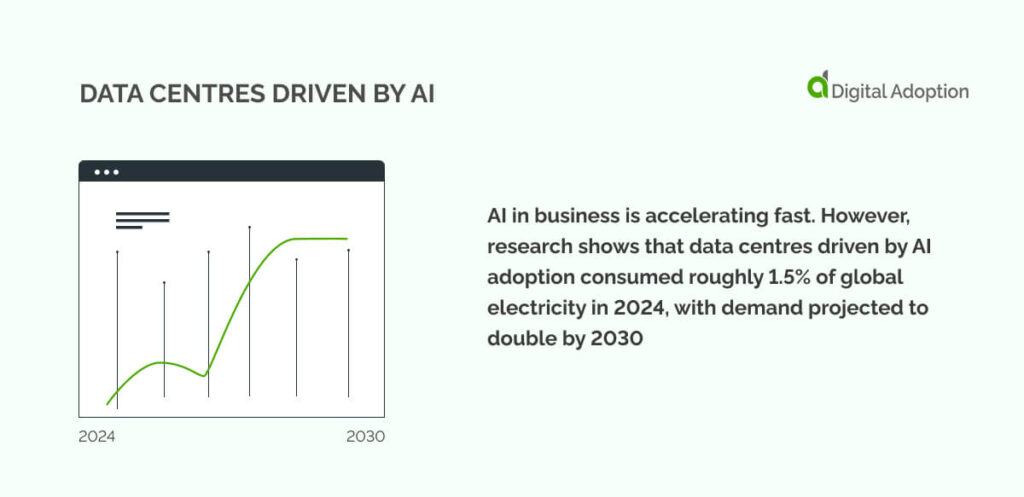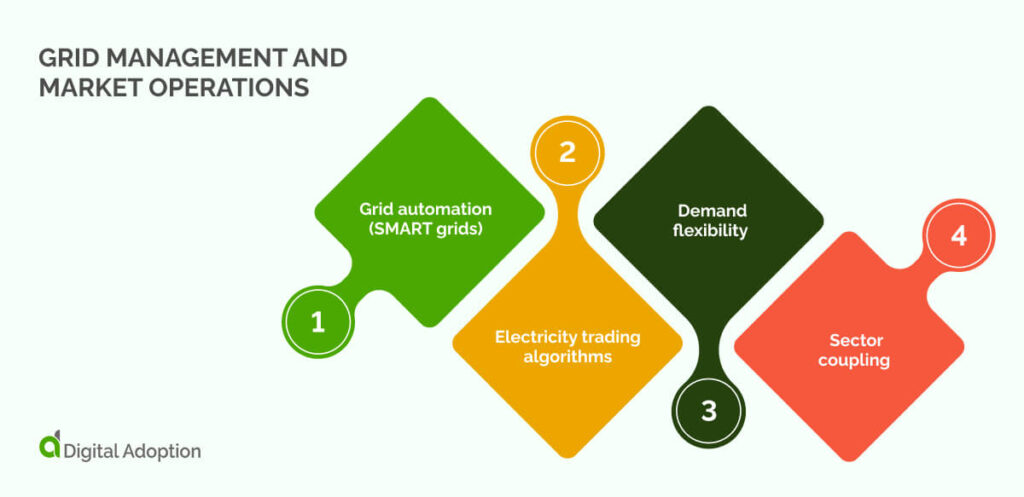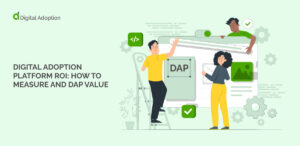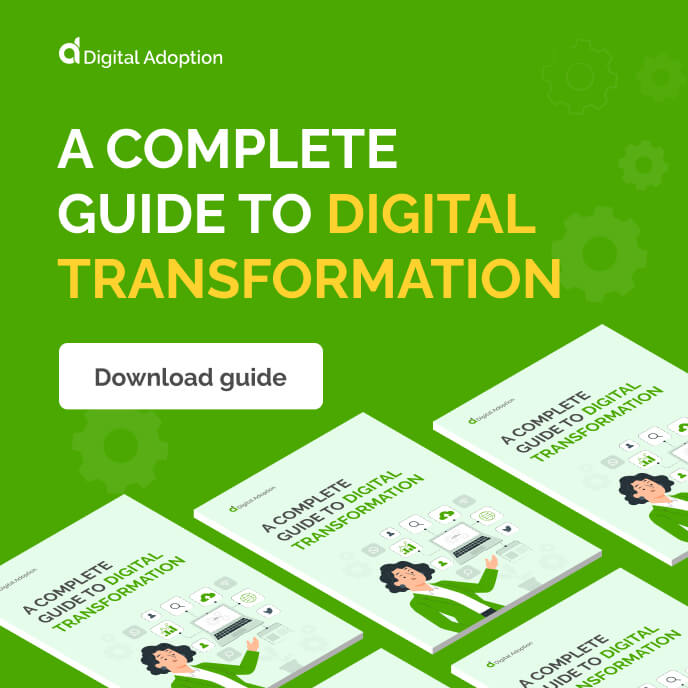In 2022, OpenAI unveiled ChatGPT, a highly sophisticated large language model (LLM) capable of engaging in natural conversation, predicting outcomes, and performing complex tasks.
AI’s ability to handle various functions has made it widely applicable across different industry domains.
As a result, AI in business is accelerating fast. However, research shows that data centres driven by AI adoption consumed roughly 1.5% of global electricity in 2024, with demand projected to double by 2030.

Larger data centers, increased processing power, and the energy required to cool AI infrastructure raise questions about sustainability and how these will meet future energy demands.
This article explores twelve examples of how advances in AI in energy are helping to offset these needs. From SMART grid management to decarbonization tech, AI balances innovation with responsible energy efficiency.
AI in energy examples at a glance:
| AI Technology | Function | Category |
| Grid automation (SMART grids) | Adjusts power flow by reading sensor data from substations and endpoints. | Grid management and market operations |
| Electricity trading algorithms | Places bids based on price trends, demand forecasts, and regional load shifts. | Grid management and market operations |
| Demand flexibility | Turns devices or systems on and off based on grid signals to balance supply loads. | Grid management and market operations |
| Sector coupling | Matches electricity use across transport, heating, and industry based on load data. | Grid management and market operations |
| Carbon capture, utilization, and storage (CCUS) | Tracks CO₂ movement through pipelines, reservoirs, and re-use systems. | Decarbonization technologies |
| Autonomous and electric mobility | Calculates energy loads, travel time, and charge points for electric fleets. | Decarbonization technologies |
| Renewable energy forecasting | Predicts wind or solar output using satellite images, weather feeds, and plant logs. | Renewables integration |
| Storage optimization | Schedules charge/discharge cycles based on real-time demand and price signals. | Renewables integration |
| Oil and gas exploration | Maps subsurface patterns using seismic and well log data to locate new reserves. | Exploration and production |
| Nuclear monitoring | Detects irregular thermal, radiation, or pressure patterns across core zones. | Exploration and production |
| Smart building systems | Adjusts HVAC and lighting based on motion, weather, and occupancy patterns. | Energy efficiency at the consumption level |
| Predictive maintenance | Flags wear in turbines or transformers using sensor feedback and historical fault data. | Energy efficiency at the consumption level |
Grid management and market operations

This category will explore examples of AI targeted at improving grid management and market operations, including scaling automation across the grid and merging siloed sectors that re-allocate resources on the fly.
Grid automation (SMART grids)
AI is making huge impacts on energy grid efficiency, with AI-automated grid operations being rolled out across networks. AI automation can store, distribute, and coordinate energy in SMART grid systems, refining outputs in response to real-time changes across sources.
Real-time monitoring through machine learning (ML) models and Internet of Things (IoT) analytics reveals network conditions and usage patterns. Power plants and substations with these AI integrations help ease pressure across the grid.
AI can forecast strain in certain nodes and shift electricity to prevent overload and outages. If faults are found, AI monitors and controls assets remotely, redirecting power to reduce disruption.
Electricity trading algorithms
Electricity markets and key suppliers are leveraging AI to fast-track trading abilities. ML algorithms monitor and react to live changes in supply and demand, combining and comparing live grid data with weather forecasts and historical trading patterns.
Instead of human-sanctioned trading that requires documentation, executive sign-offs, and logistical planning, AI now accomplishes this in a fraction of the time, placing bids, setting prices, and automating the scheduling of transfers between plants.
AI collaboration tools between suppliers and networks help manage shifting supply—algorithms factor in generation costs, demand surges, and congestion. With sufficient data, AI can simulate trading outcomes, forecast price spikes, and react faster than its human counterpart.
Demand flexibility
Flexibility in controlling energy demand is being made possible through AI. Aggregated data from various network sources is used to detect demand deficits and redirect supply to areas in need.
Because AI can balance energy transfers without jeopardising power in one key area, service disruptions are avoided. IoT sensors across the network infrastructure feed into a centralised system that predicts future spikes or excess. This gives energy suppliers a head start in slowing or halting demand along the chain.
Machine learning models factor in weather shifts, pricing signals, and grid strain, then adjust energy loads. Instead of blanket shutdowns, AI slows specific devices or systems.
Sector coupling
Sector coupling utilizes AI to integrate energy systems that previously operated independently, such as electricity, heating, and transportation.
When power is cheap or plentiful, AI directs it to heat storage or electric vehicles, thereby avoiding waste and mitigating demand spikes. It monitors usage patterns across various sectors, tracking when homes charge batteries, when factories require heat, or when rail networks draw power.
Then, it reallocates resources between them instantly. Machine learning identifies timing gaps and overlaps, enabling energy to flow where needed without overloading any one area. Instead of just storing energy, AI determines where it can be used most effectively, immediately.
Decarbonization technologies
This category explores how AI supports decarbonization efforts. Whether directly or indirectly, these solutions mitigate greenhouse gas emissions and other negative environmental impacts.
It covers AI, autonomous and electric vehicles, as well as new methods for capturing carbon directly from the atmosphere.
Carbon capture, utilization, and storage (CCUS)
AI can help in the fight against climate change through specialized technology that captures carbon before it enters the atmosphere.
Physical sensors connected to the Internet of Things (IoT) can be placed in factory settings and processing plants, transmitting live emissions readings directly to AI. The system learns how to identify chemical compounds in the air, such as carbon dioxide, nitrous oxide, and methane.
Carbon capture mechanisms within energy infrastructure are activated when they detect abnormal readings, triggering functions that capture the excess. Underground carbon storage is starting to employ AI to check for leaks in critical infrastructure.
AI uses underground seismic imaging or Ground Penetrating Radar (GPR) to track carbon flow beneath the surface. This transparency enables it to control the pace of carbon deposition and better detect weak points in containment, plugging them before they escalate.
Autonomous and electric mobility
Electric vehicles (EVs) have long signalled a shift towards more sustainable energy consumption by offering a clear alternative to non-renewable fossil fuels.
While AI is helping augment renewable energy development, it’s also taking the wheel in EV operations. AI can cleverly determine when the vehicle requires charging by monitoring and comparing various factors, including average time on the road, speed, car condition, and fuel type, to predict the optimal charging window.
AI also interconnects charging stations, understanding past data to refine logistics and communicate across the network. It foreshadows demand and lessens pressure on the grid by redistributing energy between nodes.
AI in public transportation utilizes computer vision (CV) and Internet of Things (IoT) sensors to assess passenger flow and capacity at various points on the network. It can also track vehicle locations and availability, making on-the-fly reroutes possible as it learns from daily patterns.
Renewables integration
This category explores how AI supports the integration of renewables into energy systems.
We’ll look at how storage optimisation is managed using predictive models, and how forecasting for solar and wind output is handled through real-time data analysis and weather mapping.
Renewable energy forecasting
Forecasting output from wind and solar has always been difficult. Weather moves fast, and sudden changes reach energy-generating levels without warning. AI closes that gap using satellite feeds, wind speeds, cloud cover, and historical data to predict what’s coming next, down to the hour.
ML sorts patterns from past performance to guide what a turbine or panel might produce later in the day. These forecasts are constantly updated, allowing energy suppliers to shift loads before a drop occurs. That prevents shortfalls and balances the grid with fewer surprises. The system learns each site’s habits and adjusts as needed.
Storage optimization
AI doesn’t just track battery use, it learns when to charge and when to hold back. Storage systems are designed to identify gaps between demand and renewable supply. If the sun disappears or the wind dies, AI triggers stored reserves at the right time.
It can even tell which batteries to draw from first, based on wear, location, or output quality. That helps protect equipment and avoids unnecessary strain. Solar farms often store energy while prices are low, then release it when demand surges. AI coordinates that process without delay, keeping the network better prepared.
Exploration and production
This category explores how AI is enhancing energy exploration and production. These include bleeding-edge AI technologies for oil and gas exploration and nuclear monitoring.
Oil and gas exploration
AI is driving a digital transformation in the oil and gas industry by converting vast amounts of unstructured data into real-time insights. It analyzes seismic surveys, drilling logs, and production data to identify untapped reserves and optimize well placement.
In the past, exploration relied on instinct and manual review; today, AI models simulate entire reservoirs, predict equipment failure, and automate workflows. The result is leaner operations, lower emissions, and smarter extraction across the value chain.
Nuclear monitoring
Nuclear sites are becoming safer and more efficient with smart systems that scan, detect, and predict in real time. Machine learning monitors radiation, pressure, and heat fluctuations to catch early warning signs.
Computer vision inspects equipment for damage without human exposure. Predictive tools run constant simulations, helping operators manage stress scenarios and avoid critical failures. It’s a faster, smarter way to ensure stability across increasingly complex nuclear power operations.
Energy efficiency at the consumption level
This final section shifts focus from supply to how energy is consumed. It’s where intelligent systems quietly shape everyday efficiency, learning building patterns, fine-tuning consumption, and spotting issues before they escalate.
Smart building systems
Buildings are becoming smarter with systems that learn how we use energy. AI tracks lighting, heating, and appliance use to spot where energy is wasted. It adjusts in real-time, dimming lights, lowering the heat, or turning off devices when no one is around.
These smart office technology systems operate quietly in the background, learning habits and adjusting settings to conserve energy without compromising comfort. Over time, this lowers bills and reduces the building’s overall energy footprint.
Predictive maintenance
Instead of waiting for things to break, AI helps prevent them from doing so through predictive maintenance. Sensors across various equipment, such as turbines, pipelines, or HVAC systems, feed performance data into machine learning models.
If anything runs hotter, slower, or less efficiently, AI spots the trend and alerts teams early. This stops small issues from turning into major outages. Fewer breakdowns mean smoother operations, better safety, and less wasted energy across the entire network.
Ensuring sustainable AI in the energy sector
According to Weforum, while AI plays a critical role in advancing the energy sector, it also presents a significant challenge because AI itself consumes vast amounts of energy.”
This presents a catch-22 for the energy sector. It drives efficiency and reduces emissions, yet its growing energy demands add pressure to the system.
Tools like PolicyAI help increase transparency and guide responsible use. The recent approval of the EU’s AI Act requires high-risk AI systems, including foundation models like ChatGPT, to report their energy consumption and resource use.
Effective next year, this law marks a new chapter where innovation and accountability must work together to ensure sustainable and ethical AI development.
People Also Ask
-
What are the risks of AI in energy?AI can increase energy use due to the power needed for data processing and cooling. It may also create security risks if systems are hacked or misused. Over-reliance on AI could lead to system failures or errors. Managing these risks requires a careful design, ongoing monitoring, and clear rules to ensure AI remains safe and efficient in energy systems.
-
What near-term opportunities for AI did the DOE identify in its recent report across four key areas?The DOE highlights AI’s potential to improve grid management, boost renewable energy forecasting, enhance energy efficiency in buildings, and support predictive maintenance. These advances can lower costs, reduce outages, and accelerate the transition to cleaner energy sources, making energy systems smarter and more reliable.
-
What are the environmental impacts of AI in energy?AI helps reduce emissions by optimizing energy use and supporting the adoption of renewable energy sources. However, AI itself requires significant electricity, especially for large data centers. Balancing the benefits of AI with its energy demand is key. Efforts focus on improving AI efficiency and using cleaner power to run these systems.

 FACT CHECKED
FACT CHECKED![12 Examples of AI in the Energy Sector [2025]](https://www.digital-adoption.com/wp-content/uploads/2025/06/12-Examples-of-AI-in-the-Energy-Sector-2025.jpg)







